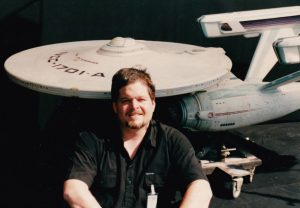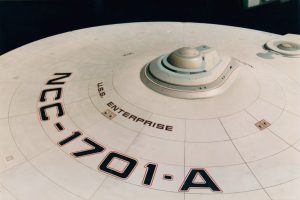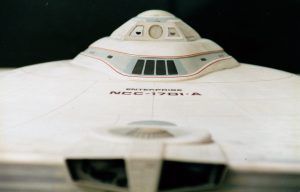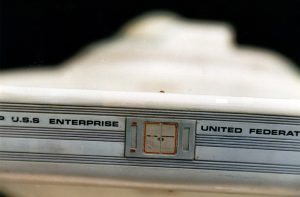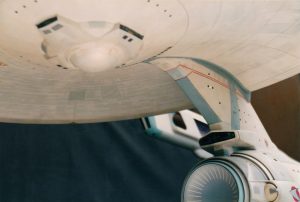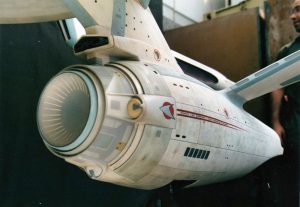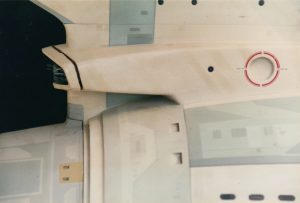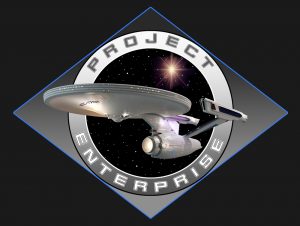 Many Star Trek fans dream big, and I love that…I really do. But what I love the most is a fan with a plan to make that dream a reality. I spoke to one such fan recently. And although I started my interview thinking his was a crazy dream without a prayer of ever happening, by the time I finished, I’d gone to his Kickstarter page and made a donation. This isn’t a fan film, but it’s a cool enough idea that I’m making an exception and sharing it with all of you.
Many Star Trek fans dream big, and I love that…I really do. But what I love the most is a fan with a plan to make that dream a reality. I spoke to one such fan recently. And although I started my interview thinking his was a crazy dream without a prayer of ever happening, by the time I finished, I’d gone to his Kickstarter page and made a donation. This isn’t a fan film, but it’s a cool enough idea that I’m making an exception and sharing it with all of you.

This dreamer is Paul Olsen, and the dream is to rebuild the model of the refit USS Enterprise exactly as it appeared in Star Trek: The Motion Picture…only 50% larger (12 feet long!). The model would travel the world in its own special display, be painted with a opalescent finish to exacting specifications, and be built to last for centuries.
Crazy, you say? Crazy awesome, you say? Not a chance of it ever happening, you say? Well, before you turn away and get on with your life, take read through this interview and see if you start believing in the dream—and the fan with the plan—just like I did…
Jonathan: Okay, who are you, Paul, and what the heck are you doing?
Paul: I’m Paul Olsen, and I had the great good fortune in 1978 and 79 to be asked to airbrush all the pearl detail on the starship Enterprise for Star Trek: The Motion Picture.
Jonathan: And a wonderful job you did of it!

Paul: Thank you. So I worked for Jim Dow, who built the Enterprise at Magicam in Hollywood. The Enterprise was designed by Richard Taylor.
Jonathan: And these two are working with you on this project…the three men responsible for the refit Enterprise! Have you been friends this entire time just waiting for your chance to recreate the magic?
Paul: Actually, we hadn’t seen each other since we’d worked on the original model. And here’s a funny thing. Even though I worked for Jim Dow, I didn’t interact at all with Richard. So I met him casually in some situation while I was working on the project, and I had no idea he’d designed this huge model I was spending each day airbrushing!
Jonathan: So what brought you three back together?
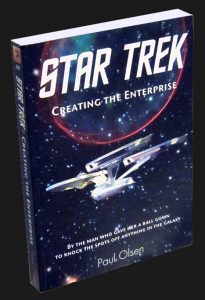 Paul: I was asked to appear at the Destination Star Trek London con in 2012 (I live over in the U.K. at the moment), and I was overwhelmed. I gave five talks to several thousand people, and I think there were 30,000 people at the con. And so I woke up Monday morning with that morning-after-the-con lovely feeling, and I thought, “Y’know, I’d better write about my small part in Star Trek.” So I wrote a book, and once I got the book out there, I got back in touch with Richard and Jim. I hadn’t seen them for 35 years!
Paul: I was asked to appear at the Destination Star Trek London con in 2012 (I live over in the U.K. at the moment), and I was overwhelmed. I gave five talks to several thousand people, and I think there were 30,000 people at the con. And so I woke up Monday morning with that morning-after-the-con lovely feeling, and I thought, “Y’know, I’d better write about my small part in Star Trek.” So I wrote a book, and once I got the book out there, I got back in touch with Richard and Jim. I hadn’t seen them for 35 years!
So I flew over to L.A., we got together, and we wondered what had happened to our model. I said that I would find out. And it took me six months to discover that Paramount had sold it off in 2006 in damaged and compromised condition. It had been re-sprayed and mishandled and chipped. It was brought by a private buyer, and it’s gone…effectively.
I know who the buyer is, and I offered to have us restore it—which would really involve tearing it completely apart and basically redoing the whole thing, bringing the electronics up to date, and then my resurfacing the whole Enterprise.
Jonathan: Sounds similar to what just happened with the TOS Enterprise at the Smithsonian. Lots of intricate restoration.
Paul: Very similar. And in fact, part of the deal I was offering was that, after we were finished, the Enterprise would have to be available for the public, to go out on the road. And he didn’t want to do that. So that was that.
Jonathan: Bummer.
Paul: Well, then Boyd Crompton at Trekworks in San Antonio wrote to me, and he said, “Paul, why don’t you guys—since you’re still around—why don’t you build another one and make it better, bigger, with all modern electronics and everything?” So I thought about it, and I got a hold of Richard and Jim, and then I came back to L.A. We knocked it around, and Boyd came out, too…and we decided to do it.
Jonathan: Yay!
Paul: Well, we decided to it, but then they said, “Paul, it’s up to you.” So I’ve spent the last two years starting from scratch and trying to build a presence, design a website, etc. And I finally got to the point where I met Nichelle Nichols, and she very, very kindly said, “Paul, I’ll unveil it for you. Get the thing built, and I’ll unveil it. We’ll do a big thing at Grauman’s Chinese Theater.” And as it turns out, a friend of Richard’s owns Grauman’s, and so I’ve got this whole thing planned.
But I still have to get there. It’s a two-year project…because we’re not just gonna build the Enterprise. Richard is really into virtual reality now; he’s at the cutting edge. And he’s going to design a complete display unit in which the Enterprise will be floating and moving. She’ll look and sound like she’s flying through space and time.
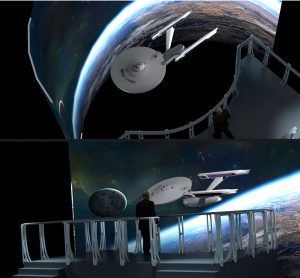
And it’s going to cost a ton of money. But I have to get to the point where I get the message out to all the fans. So I’m building it up. In addition to Nichelle, I’ve got Rod Roddenberry lending his support, Tim Russ just joined us, and we’ve approached George Takei, as well. Richard directed George in a film, and I’ve met him a few times. He said he’d love to do it, but we weren’t really far enough along yet for him to get involved. But now that we’ve got Nichelle and Rod and Tim, we’ll be going back to George.
Jonathan: Well, George Takei’s Facebook posts have been known to work magic on Kickstarter campaigns! And speaking of which, you’ve got a Kickstarter going right now with a goal of $50,000. Is that all it’s going to cost to build this model and display?
Paul: Oh, hardly! The current Kickstarter campaign is to raise enough money for me to hire a top PR firm in America for two or three months at five to ten grand a month to get me on the air all over America–radio and TV–but very big shows as well as local stuff. So I’ll have to fly over, rent a car, and basically spend two or three months on the road, staying in cheap motels, and hitting all the radio stations and TV stations. I’ve done it before, pushing a book I wrote back in 2004 and was very successful, and I know the drill.
So that’s what I’m raising the money for, so that through the mainstream media, I can get the word out there to the fans all over the world. And then we can start raising the money to actually start building the Enterprise and also pulling in sponsors because we’ll have our heads above the parapet at that point. So the current Kickstarter campaign goes until September 11.
Jonathan: How much will it cost to build the final model and traveling display then?
Paul: We’re in the $3 million ballpark, and it’s a two-year project.
Jonathan: WOW!
Paul: Well, the original model, in today’s dollars, cost about six and a half million. And that was with everybody working at very cheap rates, back when everyone was making $15/hour.
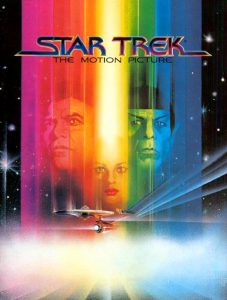 Jonathan: That’s interesting. I’d always heard that the effects for Star Trek: The Motion Picture were really expensive, but I never imagined…
Jonathan: That’s interesting. I’d always heard that the effects for Star Trek: The Motion Picture were really expensive, but I never imagined…
Paul: Do you know what that picture cost?
Jonathan: I think, at the time, it was around $40-50 million, right?
Paul: It was, by far, the most expensive motion picture made up to that point. And the bookkeeping was very difficult because so many different hands got involved in so many different stages in the making of the movie. But as near as anyone can tell who was working on the film, it was $120 million.
Jonathan: I had no idea!
Paul: Even though you get all kinds of numbers from $40 to $80 million on the Internet, they’re wrong. After I finished the Enterprise, Doug Trumbull asked me to help with the special effects because everyone was up against it. We were working 14 to 16 hours a day, seven days a week. Everybody was making overtime, and in the movie business, you get double-time for your first four hours over eight hours, then you get what’s called golden time, and that’s four times your rate. And so people were just pulling down horrendous amounts of money! The cinematographer was making fifty grand a week! It’s an expensive business.
Jonathan: How long did it take to build the refit Enterprise?
Paul: From start to finish, I got it and it was already six months along, and it took me another eight months. So a little over a year.
Jonathan: It took you eight months just to paint the thing? That’s quite a paint job!
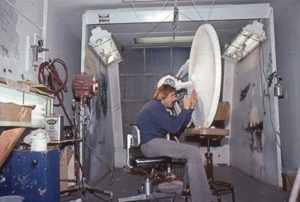
Paul: Well, this is something that has to look a thousand feet long on a movie screen, and you don’t just knock it out. The camera lens on some of the shots was only two or three inches off the surface. It had to look big.
Jonathan: Man, computer-rendered digital effects have spoiled me. In my mind, I was just thinking: “Well, just use a higher resolution texture map.” I forgot this was 1979. So how big was the original model, and will your model be the same size?
Paul: The original was about eight feet long and maybe four feet wide. Our new model will be 50% larger, so that’ll be about twelve feet by six feet.
Jonathan: I just wanted to make sure it’ll fit on a truck so you can transport it.
Paul: Yes. And because we’re going to travel it around the world, we’re going to really have to look at how we put the thing together, and if it comes apart and gets reconstructed each time or we make it one solid piece and it’s transported that way…like the original was. We also have to build the display, and that will take as much time and cost as much as the Enterprise. And then we have to build all the flight cases and all the support equipment…the videos, the cameras, the projection equipment, sound equipment, maintenance equipment, and then tools and all the rest of it. This is a huge deal!
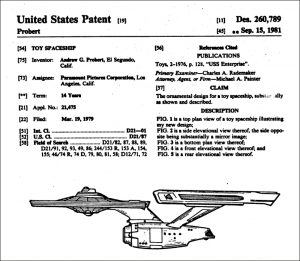
Jonathan: Well, that leads me to my next question. We are all well aware that the folks at Axanar are being sued for potentially millions of dollars. And here is something that is so iconic that not only is there a copyright, but there was actually a patent! Granted, I’m not sure whether the patent expired [ed. note: it did…in 1995 –Jonathan], but this is the sort of thing where it sounds like the folks at CBS might have something to say about you traveling around the world with their starship. How are you planning to address that?
Paul: Rod introduced me to the guy at CBS who’s in charge of licensing, John Van Citters. He’s a really nice guy.
Jonathan: Really nice guy. I used to work for him.
Paul: Did you?
Jonathan: Yep, for a few years when Star Trek licensing was still handled by Viacom. John’s an awesome person. I hate his fan film guidelines, but I love John himself.
Paul: Yeah, I can see both sides of the issue. I know Alec, and he’s getting screwed. But at the same time, CBS is just trying to protect what’s theirs.
Jonathan: And now we’ve discussed fan films, Paul, so your interview can officially be on my blog! But let’s get back to licensing your project…
Paul: Well, I’ve contacted John Van Citters via e-mail, and he’s looking into our project and whether they can authorize us.
Jonathan: And what if John and CBS say no?
Next time: We’ll learn the answer to that cliffhanger question and also find out how Paul is planning to come up with $3 million. And what’s this I hear about a documentary film? And finally, I indulge my inner geek and ask why the Enterprise paint job looked so much better in the first feature film than in the other five.
To donate, click here to and visit their Kickstarter page.
As a special bonus, here are some photos I took way back in December of 2000 when Foundation Imaging in Valencia, CA was preparing to do CGI effects for a remastered Star Trek: The Motion Picture DVD release. Paramount loaned Foundation the Enterprise, Klingon D-7, and Work Bee to study and take measurements, and I took a few rolls of photos myself. Here are some of the best shots (click on any to enlarge)…
